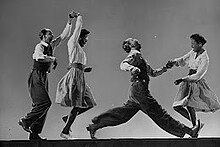
Back Lindy-hop Catalan Lindy hop Czech Lindy Hop Danish Lindy Hop German Λίντυ Χοπ Greek Lindy hop Spanish لیندی هاپ Persian Lindy hop Finnish Lindy hop French לינדי הופ HE


The Lindy Hop is an American dance which was born in the African-American communities of Harlem, New York City, in 1928 and has evolved since then. It was very popular during the swing era of the late 1930s and early 1940s. Lindy is a fusion of many dances that preceded it or were popular during its development but is mainly based on jazz, tap, breakaway, and Charleston. It is frequently described as a jazz dance and is a member of the swing dance family.
In its development, the Lindy Hop combined elements of both partnered and solo dancing by using the movements and improvisation of African-American dances along with the formal eight-count structure of European partner dances – most clearly illustrated in the Lindy's defining move, the swingout. In this step's open position, each dancer is generally connected hand-to-hand; in its closed position, leads and follows are connected as though in an embrace on one side and holding hands on the other.
There was renewed interest in the dance in the 1980s from American, Swedish, and British dancers and the Lindy Hop is now represented by dancers and loosely affiliated grass-roots organizations in North America, South America, Europe, Asia, and Oceania.
Lindy Hop today is danced as a social dance, as a competitive dance, as a performance dance, and in classes, workshops, and camps. Partners may dance alone or together, with improvisation a central part of social dancing and many performance and competition pieces.
Lindy Hop is sometimes referred to as a street dance, referring to its improvisational and social nature. In 1932, twelve-year-old Norma Miller did the Lindy Hop outside the Savoy Ballroom with her friends for tips.[1] In 1935, 15,000 people danced on Bradhurst Avenue for the second of a dance series held by the Parks Department. Between 147th and 148th street, Harlem "threw itself into the Lindy Hop with abandon" as Sugar Hill residents watched from the bluffs along Edgecombe Avenue.[2]
- ^ Miller, Norma (1996). Swingin' at the Savoy: The Memoir of a Jazz Dancer. Cambridge, Massachusetts: Candlewick Press. pp. 11. ISBN 0-7636-2244-3.
- ^ "15,000 Dance in Street". The New York Times. July 17, 1935. p. 21. Archived from the original on May 26, 2023. Retrieved February 11, 2020.